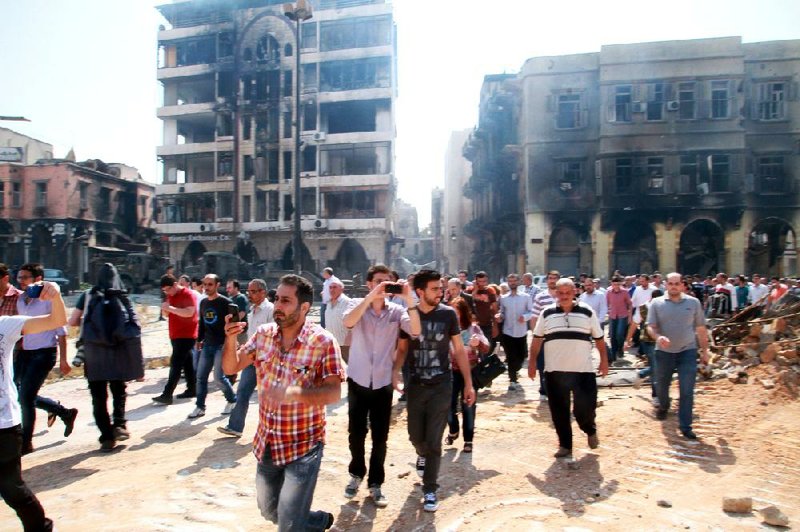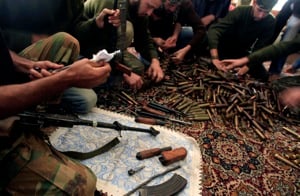HOMS, Syria -- Hundreds of Syrians wandered down paths carved out of rubble in the old quarters of Homs, getting their first glimpse Friday of the destruction that two years of fighting inflicted on rebel-held parts of the city.
City blocks were pounded into a vista of hollow facades of blown-out buildings. Dust was everywhere. Streets were strewn with rebar, shattered bricks, toppled telephone poles and the occasional charred, crumpled shells of cars.
For more than a year, President Bashar Assad's troops blockaded the neighborhoods, pounding the rebel bastions with his artillery and air force. Under a deal struck this week, the government assumed control of the old quarters, while in return some 2,000 rebel fighters were granted safe passage to opposition areas north of Homs.
The final piece of the agreement fell into place Friday afternoon as the last 300 rebels left Homs after an aid convoy was allowed into two pro-government villages in northern Syria besieged by the opposition. The aid delivery was part of the Homs agreement.
The withdrawal was a major victory for the government in a conflict that has killed more than 150,000 people since March 2011. The deal handed Assad control of the city once known as "the capital of the revolution," as well as a geographic linchpin in central Syria from which to launch offensives on rebel-held territory in the north.
Even before the last rebels departed, government bulldozers were clearing paths through the heaviest rubble in Homs' battle-scarred districts Friday. It was the first time government troops had entered the neighborhoods -- the last rebel bastions in the city -- in more than a year.
Homs Gov. Talal Barazi said engineering units were combing Hamidiyeh and other parts of the old quarters in search of mines and other explosives. State TV said two soldiers were killed while dismantling a bomb.
The SANA state news agency reported that army troops discovered two field hospitals in the neighborhoods of Bab Houd and Qarabis, as well as a network of underground tunnels linking the districts to one another and to the countryside.
Soldiers and pro-government militiamen fanned out across the districts to provide security. In Hamidiyeh, a predominantly Christian neighborhood before the fighting, people trickled back in to check on their properties.
Imad Nanaa examined his home for the first time in almost three years. He was surprised to find it almost intact, unlike other houses with shattered windows and crumbling walls.
Speaking hurriedly because he wanted to leave as quickly as possible, Nanaa said he was looking forward to returning with his family as soon as the army allowed it.
"This deal has saved us from more blood and destruction," he said.
Later, hundreds of men, women and children walked through parts of the 8-mile-long old quarters, flashing victory signs and taking pictures. Some men in the first group dashed inside, passing burned-out cars and heavily damaged buildings.
People returning were required to hand over their IDs to the troops upon entering the formerly rebel-held districts. The soldiers then returned the papers as the people left.
One man walked out with a guitar under his arm. A woman emerged from her home carrying a stack of photo albums.
"I have nothing left for me to remember, so I brought these photos," the woman, Fadia al-Ahmar, said. "My house was destroyed."
In the Maljaa neighborhood, every building was damaged, along with parked cars. An eight-story building was flattened into rubble. Shop fronts were pancaked. Walls of apartment blocks were blasted with holes from artillery and tank shells.
Back in Hamidiyeh, the historic St. Mary Church of the Holy Belt was heavily damaged, although the thick stone walls were still standing. There were no pews and some of the icons were disfigured. The Syriac Orthodox church's damaged bell lolled on the ground in the courtyard.
The Greek Orthodox bishop in Homs, George Abu Zakhm, said the situation there is "catastrophic." He said all 11 churches in Homs' old quarter have been either heavily damaged or destroyed.
He accused the rebels of lighting a fire inside the sixth-century Greek Orthodox St. Elian Church, and said icons dating back hundreds of years "are still on the walls but they were blackened."
Islamic extremists among Syria's rebels have desecrated churches elsewhere in Syria. But every building in central Homs bore scars, suggesting that fighting -- not opposition members -- was responsible for the damage to the Christian sites there.
Information for this article was contributed by Bassem Mroue and Barbara Surk of The Associated Press.
A Section on 05/10/2014


